Sorghum (Sorghum bicolor) is one of the world’s least exploited cereal crops, but remains a staple grain for millions of poor people in Africa. Sorghum is used in South Africa to make traditional sorghum beer (umqombothi), alcoholic beverages, non-alcoholic drinks (mageu), fibre, starch, paper, soups, and cakes for human consumption. It has also recently been used as a source of biofuel. Due to its resilience, this C4 crop is well adapted to arid and semi-arid regions, where other cereal crops such as maize often fail to thrive – making it an ideal crop in the light of climate change.
Despite its resilience, newly improved short- and medium-duration sorghum cultivars grown in South Africa are susceptible to a number of diseases of economic importance. Most foliar and panicle diseases that were previously not economically significant to South Africa, are now – primarily as a result of additional difficulties brought on by climate change (longer periods of rainfall and heat during the growing season) and the introduction of new higher yielding cultivars.
These fungal diseases frequently pose a threat just before or during the course of the reproductive developmental stages. In humid, tropical and subtropical regions, biotic factors such as fungus-related leaf diseases and grain moulds, contribute considerably to losses in grain production, especially on improved short- and medium-duration sorghum cultivars. More sorghum will be produced in the coming planting season, which will present new disease challenges caused by fungi, bacteria, and viruses. Additionally, some of these pathogens (namely the panicle diseases) reduce grain quality, resulting in direct grain loss. Many are also mycotoxigenic (producing mycotoxins), restricting the crop’s uses for human consumption, animal feed and reducing the quality of grain significantly. Leaf diseases reduce the plant’s photosynthetic area, resulting in yield losses.
Foliar and leaf diseases of concern for sorghum production in South Africa
Turcicum leaf blight (TLB)
TLB caused by Exserohilum turcicum (Photo 1) is a polycyclic disease that is encouraged by considerable rainfall (>600 mm), moderate temperatures (25°C), high humidity, and the presence of significant primary inoculum. TLB may be more common in young plants, but can inflict more harm on older plants due to the post-anthesis foliage’s increased susceptibility. TLB is more prevalent in areas with a moderate climate and high humidity during the growing season. In sorghum-producing countries, the incidence of epidemics of the strain of E. turcicum is particularly pathogenic in a specific area or on specific cultivars.
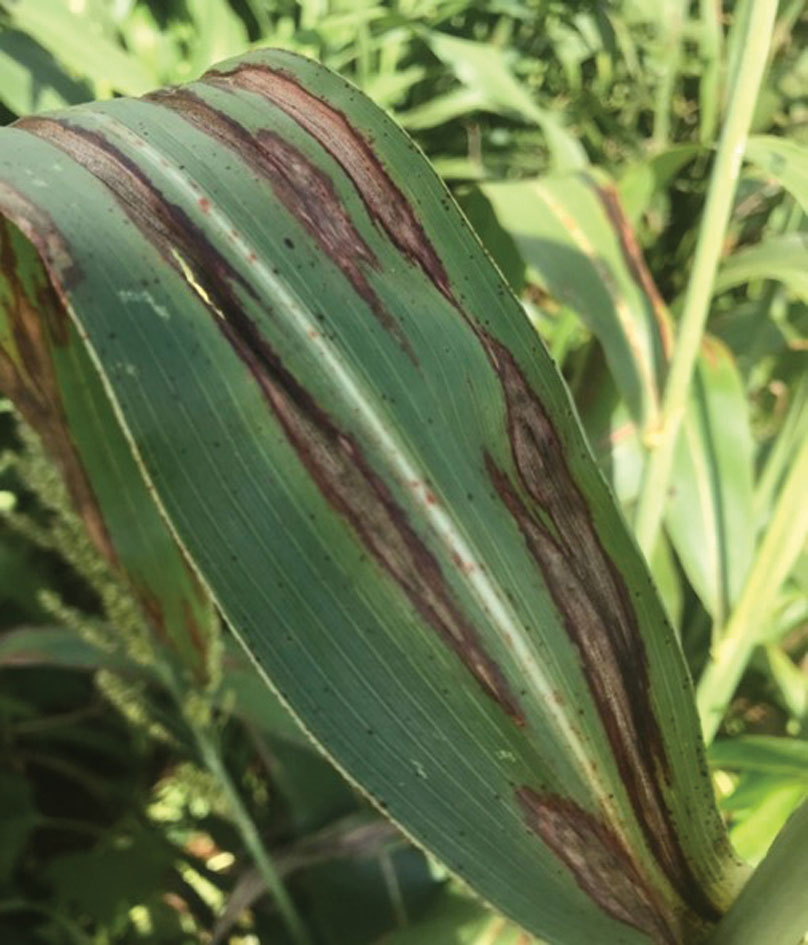
Anthracnose leaf blight
Anthracnose leaf blight (Photo 2), caused by Colletotrichum sublineola, is one of the most significant diseases in sorghum. Warm, humid climates favour the development and spread of the disease. Leaves infected by anthracnose develop a yellow, light to tan colour, then brown leaves that eventually die while newer leaves often become red. Anthracnose infection is highly prevalent in areas with high temperatures of about 28˚C to 30˚C, and high relative humidity. It can limit grain production of sorghum up to 25% where continuous rainfall is experienced during the growing season.
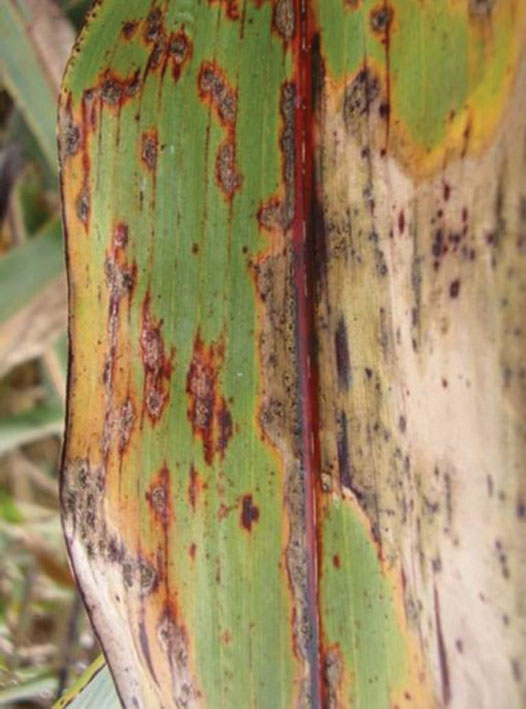
Source: NW McLaren
Sorghum rust
Caused by the fungus Puccinia purpurea, sorghum rust (Photo 3) infects sorghum at all growth stages. First symptoms appear as small specks on the lower leaves (purple, tan or red depending upon the cultivar). Pustules (uredosori) emerge on both leaf surfaces as purplish patches that erupt to discharge reddish powdery masses of uredospores which further infect the specific neighbouring or following crops. Rust outbreaks generally occur late in the growing season during grain filling, and they barely affect yield. However, when the crop suffers spells of cool, rainy weather earlier in the season, disease outbreaks may occur and cause yield reductions. When it infects susceptible cultivars before anthesis, sorghum rust can cut yields by 13%. High relative humidity, heavy dews, rain, and low temperatures might worsen this disease. Additionally, rust can make the crop more susceptible to other stem rot diseases, like charcoal rot or Fusarium stalk rot.
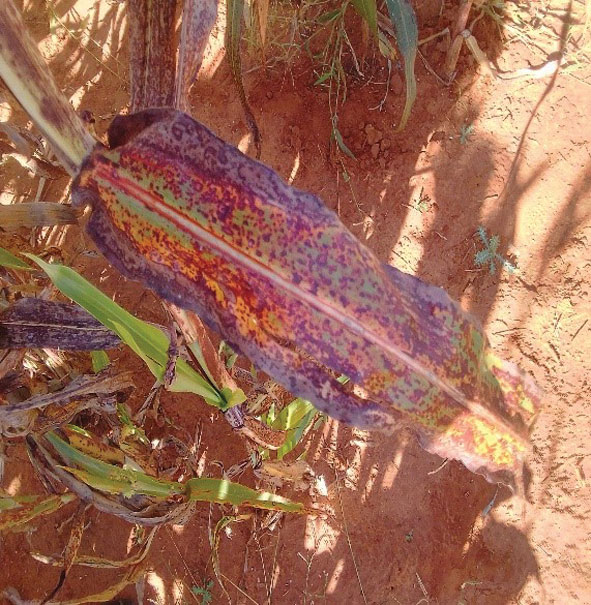
Sorghum ergot
Sorghum ergot (Claviceps africana) influences grain quality of sorghum (Photo 4) by infecting the ovary of sorghum flowers and often converting them into a white, fungal mass (sphacelia). The most extensive external symptom of infection is the abundant exudation from the infected flowers of an amber-coloured, sticky fluid or ‘honeydew’, which often drips onto the leaves and soil. Spores of the fungus are contained within the honeydew, and when these germinate, they produce secondary spores on the surface of the honeydew, giving it a powdery or white scum appearance. Wind rapidly spreads these secondary spores over long distances.
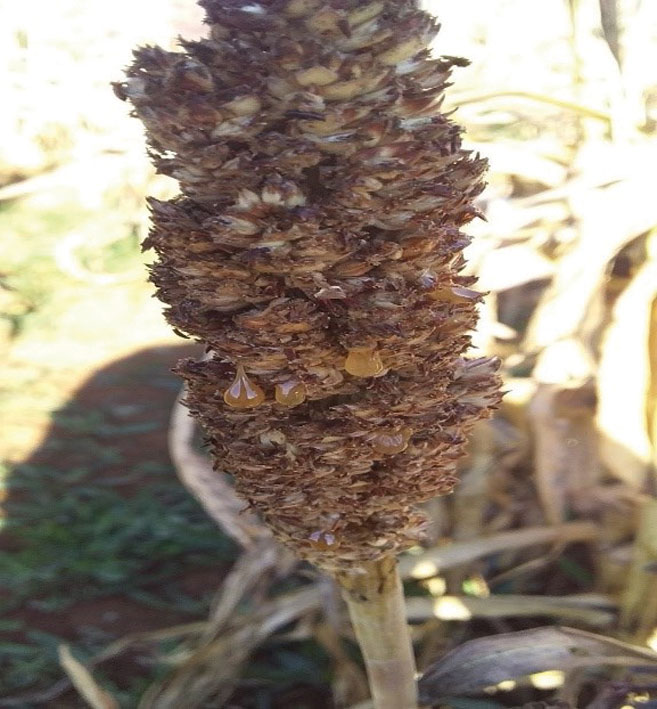
The fungus can also be spread by seed contaminated with sphacelia or honeydew. Under certain conditions, C. africana produces very durable, compact fungal structures called sclerotia. Ergot thrives under cool temperatures during flowering and high humidity where the ergot spore outcompetes the pollen to reach the ovary of the developing grain. In South Africa, for instance, sorghum is planted later in the season and flowers when temperatures are beginning to cool down – thus higher ergot infection rates will be observed.
Grain mould (GM)
GM (Photo 5), resulting from a group of fungal infections, infects the spikelet tissues of sorghum in the early stages of grain development. These are, in approximate order of importance, Fusarium verticillioides, Curvularia lunata (Wakker) Boedijn, F. semitectum Berk. & Rav., and Phoma sorghina (Sacc). F. verticillioides and C. lunata are of greatest significance worldwide. Symptoms of early infection and post-maturity colonisation can be very different. Early infection by a GM pathogen occurs on the apical portions of spikelet tissues: glumes, lemma and palea.
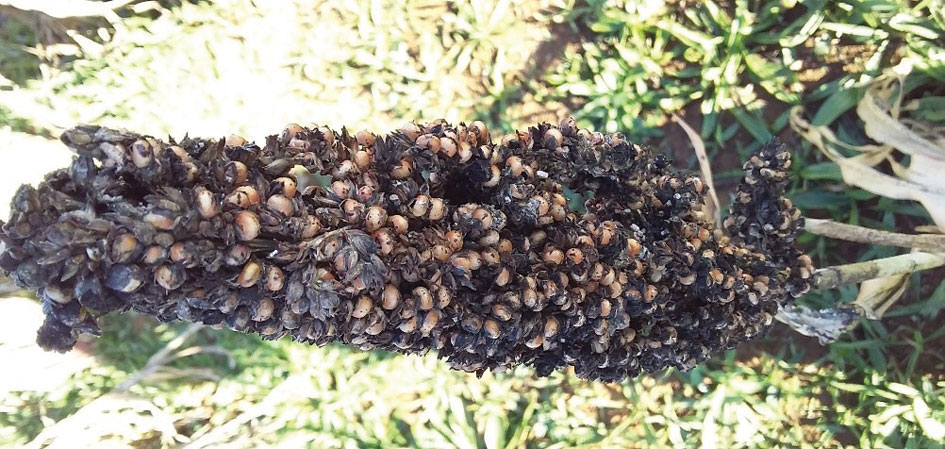
Colonisation then proceeds toward the base of the spikelet, either in the spikelet tissues or in voids between these tissues. Infection of the grain itself occurs at the base, near the pedicel, and can interfere with grain filling and/or cause a premature formation of the black layer resulting in a reduction in grain size. The first signs of the fungus occur at the hilar end of the grain, and subsequently extend acropetally on the pericarp surface. Grain moulds prefer high relative humidity and humid weather during and after flowering up until grain maturity prior to harvest. Climatic conditions determine whether pathogen infection and growth will ultimately spread to that part of the grain not covered by the glumes.
Control measures
Producers sometimes spray fungicides prophylactically, however, the timing of sprays needs to be optimised for each disease. This is difficult as each has its own different peak period in the growing season. Other control measures include the use of disease-free seed, rotation, planting resistant hybrids, avoidance (planting dates) and the use of registered fungicides. Integration of these different control measures will reduce the impact of diseases if applied properly.
Contact the authors at 018 299 6100 for further advice on developing integrated control systems.



























